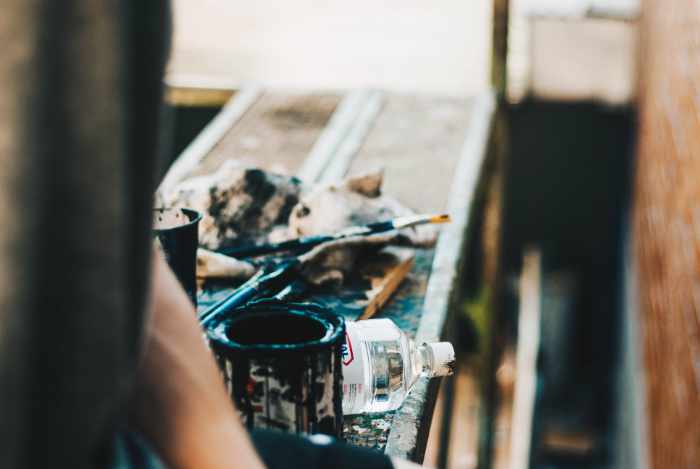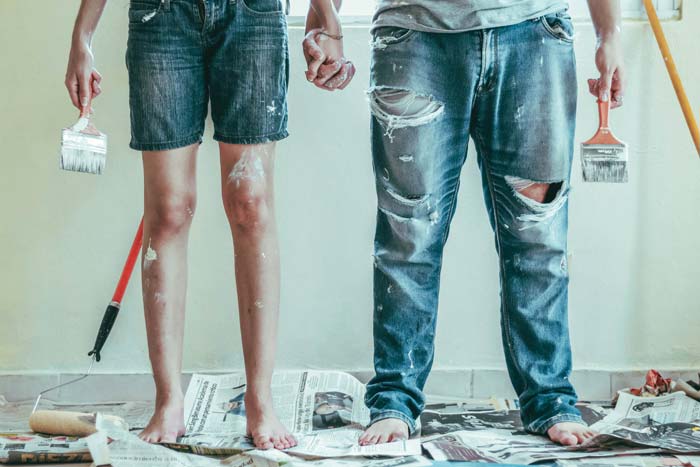Color theory is a fundamental concept in art and design that explores the relationships between colors, their psychological effects, and how they can be harmoniously combined. Applying color theory principles to your home paint jobs can elevate your interior and exterior spaces, creating a cohesive and visually appealing atmosphere. So read on to discover how you can use color theory for trend home painting projects complete with practical tips!

Incorporating Trends with Caution
While color theory provides timeless principles for creating harmonious color schemes, it’s also essential to keep an eye on current color trends. Trends can provide inspiration and fresh ideas for your home paint job and the latest house painting statistics will showcase the best trends for this year. It’s crucial to incorporate them with caution and not to overcommit to fads.
You can add trendy colors as accents or through easily changeable elements like decor, furniture, and accessories. This way, you can keep your home looking current while maintaining a timeless and enduring base color scheme that adheres to the principles of color theory.
Understanding Color Basics
Before you can create a stylish and harmonious color scheme for your home, it’s essential to understand the basics of color theory. Color theory is based on the color wheel, which consists of primary colors (red, blue, and yellow), secondary colors (green, orange, and purple), and tertiary colors (colors created by mixing primary and secondary colors).
- Primary Colors: These are the building blocks of color theory and cannot be created by mixing other colors. Red, blue, and yellow are primary colors. When combined in various ways, they form the basis for all other colors in the spectrum.
- Secondary Colors: Secondary colors are created by mixing two primary colors. Green is the result of combining blue and yellow, orange emerges from the fusion of red and yellow, and purple is the product of mixing red and blue. These secondary colors are essential for creating vibrant and diverse color palettes.
- Tertiary Colors: Tertiary colors come into play when you mix a primary color with an adjacent secondary color on the color wheel. For example, mixing red (a primary color) with orange (a secondary color) produces a tertiary color known as “red-orange.” This process allows for even more nuanced and subtle color options.
Complementary Colors
Understanding the concept of complementary colors is key to creating dynamic color schemes. Complementary colors are those that are opposite each other on the color wheel, such as red and green or blue and orange. When used together, they create high-contrast and visually striking combinations that can add excitement and interest to your home’s decor.
Choosing a Color Scheme
Selecting the right color scheme is crucial for achieving a trendy look in your home. Color schemes can be broadly categorized into monochromatic, complementary, analogous, and triadic. Monochromatic schemes use different shades and tints of a single color, creating a serene and sophisticated atmosphere. Complementary schemes involve colors opposite each other on the color wheel, offering high contrast and energy.
Analogous schemes use colors that are adjacent to the color wheel, resulting in a harmonious and calming environment. Triadic schemes involve three evenly spaced colors on the wheel, providing a balanced and vibrant feel. Consider the mood and purpose of each room in your home when choosing a color scheme.
Creating Balance and Contrast
Achieving balance and contrast in your home’s color palette is essential for a trendy and visually engaging interior. Balance involves distributing colors evenly throughout a space, ensuring no single color dominates. You can achieve balance by using a dominant color, a secondary color, and an accent color in your chosen color scheme. Contrast, on the other hand, is about creating visual interest by juxtaposing light and dark colors or warm and cool tones. Experiment with different textures, finishes, and patterns to enhance the contrast and make your home paint job stand out.
Considering the Psychological Effects of Colors
Colors have a profound impact on our emotions and perceptions, so it’s essential to consider the psychological effects of your chosen colors. For example, warm colors like red and orange can evoke feelings of energy and warmth, making them suitable for social spaces like the living room or dining room. Cool colors like blue and green are calming and work well in bedrooms and bathrooms. Neutral colors like beige and gray create a timeless and versatile backdrop for any room. Be mindful of the emotions and ambiance you want to convey in each space to ensure your color choices align with your vision.
Experimenting with Paint Finishes
When applying color theory to your home paint jobs, don’t overlook the importance of paint finishes. The choice of finish can significantly impact how a color appears and how light interacts with it. Common paint finishes include flat, matte, eggshell, satin, semi-gloss, and high-gloss. Flat and matte finishes are perfect for concealing imperfections on walls and ceilings and creating a soft, elegant look.
Eggshell and satin finishes have a slight sheen and are easier to clean, making them ideal for high-traffic areas like kitchens and bathrooms. Semi-gloss and high-gloss finishes are highly reflective, giving a sleek and polished appearance but are often reserved for trims, doors, and accents. Experiment with different finishes to enhance the visual interest and texture within your color scheme.
Testing Paint Samples
Before committing to a particular color, it’s essential to test paint samples in the actual space you plan to paint. Lighting conditions can vary throughout the day, and the colors may appear differently on your walls than on a paint chip or in a catalog. Paint small sections or large swatches of your chosen colors on the walls to observe how they look in different lighting scenarios. Take note of how natural light, artificial light, and shadows affect the colors. Testing paint samples will help you make an informed decision and avoid costly mistakes that can arise from selecting the wrong color.

Understanding color basics, selecting the right color scheme, achieving balance and contrast, considering the psychological effects of colors, experimenting with paint finishes, testing paint samples, and cautiously incorporating trends are all essential aspects of using color theory effectively. By embracing these principles and techniques, you can confidently embark on your home improvement project, ensuring that your choice of colors and finishes aligns with your vision and creates a stunning environment that reflects your unique style and personality.



